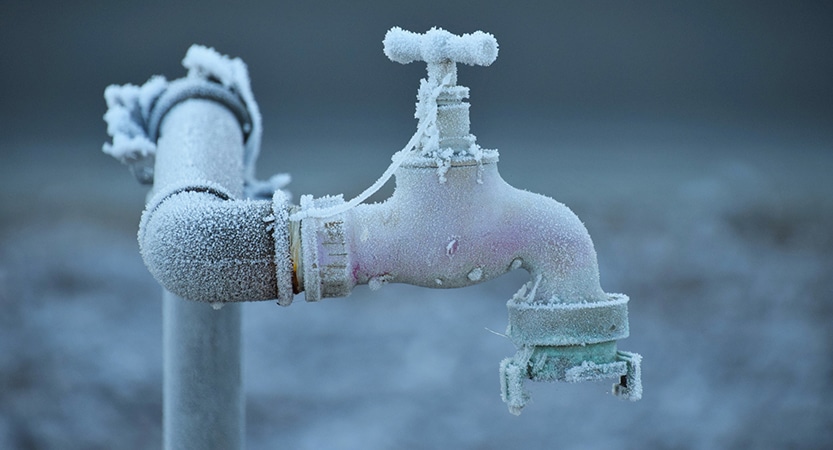Crucial Advice to Prevent Frozen Plumbing in Cold Weather
Crucial Advice to Prevent Frozen Plumbing in Cold Weather
Blog Article
The author is making a number of good pointers related to Prevent Frozen Pipes overall in this content following next.

Cold weather can wreak havoc on your pipes, specifically by freezing pipes. Here's how to stop it from taking place and what to do if it does.
Introduction
As temperatures drop, the danger of frozen pipelines boosts, potentially causing costly fixings and water damages. Comprehending how to stop frozen pipelines is important for home owners in cool climates.
Prevention Tips
Insulating prone pipelines
Cover pipelines in insulation sleeves or use warmth tape to shield them from freezing temperatures. Focus on pipelines in unheated or outside areas of the home.
Heating methods
Keep indoor rooms properly warmed, specifically areas with plumbing. Open cupboard doors to enable warm air to flow around pipes under sinks.
Exactly how to identify frozen pipelines
Try to find reduced water circulation from taps, unusual smells or sounds from pipes, and visible frost on revealed pipelines.
Long-Term Solutions
Architectural modifications
Take into consideration rerouting pipes away from exterior wall surfaces or unheated areas. Include added insulation to attic rooms, cellars, and crawl spaces.
Upgrading insulation
Purchase top notch insulation for pipes, attic rooms, and wall surfaces. Correct insulation aids preserve constant temperatures and reduces the risk of frozen pipelines.
Protecting Exterior Pipes
Garden hose pipes and exterior taps
Disconnect and drain garden hose pipes before winter season. Mount frost-proof faucets or cover outdoor faucets with shielded caps.
Recognizing Frozen Pipes
What creates pipes to ice up?
Pipelines freeze when revealed to temperature levels listed below 32 ° F (0 ° C) for prolonged periods. As water inside the pipelines ices up, it broadens, putting pressure on the pipeline wall surfaces and potentially causing them to rupture.
Dangers and problems
Icy pipelines can lead to water disturbances, residential or commercial property damages, and expensive repairs. Burst pipes can flood homes and cause substantial structural damages.
Indications of Frozen Pipes
Determining frozen pipes early can prevent them from rupturing.
What to Do If Your Pipelines Freeze
Immediate actions to take
If you presume frozen pipes, keep faucets open up to eliminate stress as the ice thaws. Utilize a hairdryer or towels taken in warm water to thaw pipelines slowly.
Final thought
Stopping frozen pipes requires aggressive actions and fast responses. By comprehending the reasons, signs, and safety nets, homeowners can secure their plumbing throughout cold weather.
5 Ways to Prevent Frozen Pipes
Drain Outdoor Faucets and Disconnect Hoses
First, close the shut-off valve that controls the flow of water in the pipe to your outdoor faucet. Then, head outside to disconnect and drain your hose and open the outdoor faucet to allow the water to completely drain out of the line. Turn off the faucet when done. Finally, head back to the shut-off valve and drain the remaining water inside the pipe into a bucket or container. Additionally, if you have a home irrigation system, you should consider hiring an expert to clear the system of water each year.
Insulate Pipes
One of the best and most cost-effective methods for preventing frozen water pipes is to wrap your pipes with insulation. This is especially important for areas in your home that aren’t exposed to heat, such as an attic. We suggest using foam sleeves, which can typically be found at your local hardware store.
Keep Heat Running at 65
Your pipes are located inside your walls, and the temperature there is much colder than the rest of the house. To prevent your pipes from freezing, The Insurance Information Institute suggests that you keep your home heated to at least 65 degrees, even when traveling. You may want to invest in smart devices that can keep an eye on the temperature in your home while you’re away.
Leave Water Dripping
Moving water — even a small trickle — can prevent ice from forming inside your pipes. When freezing temps are imminent, start a drip of water from all faucets that serve exposed pipes. Leaving a few faucets running will also help relieve pressure inside the pipes and help prevent a rupture if the water inside freezes.
Open Cupboard Doors
Warm your kitchen and bathroom pipes by opening cupboards and vanities. You should also leave your interior doors ajar to help warm air circulate evenly throughout your home.

Hopefully you enjoyed our topic about How To Avoid Freezing Pipes. Thanks a ton for taking time to browse our blog post. Loved our write up? Please quickly share it. Let other people check it out. We take joy in your readership.
Details Report this page